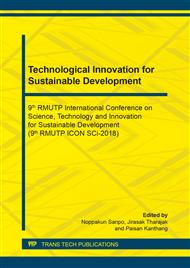p.3
p.9
p.14
p.21
p.30
p.41
p.52
p.60
Newly Established Method for Analyzing the Natural Ethylene Indicators Dissolved in Water Immersed Plant Using Acidified Potassium Manganate
Abstract:
Ethylene is a plant growth regulator (PGR) that mainly influences on growth and development of plant and their agricultural productivity. Ethylene producing from plant tissue is a physiological indicator which refers to the maturity, senescence, or stress of plants. Therefore, a monitoring level of ethylene in plant tissue is necessary for research and commercial processes. Current method measuring gaseous ethylene is costly and take a long time. This research established a new method to quantify ethylene gas in water immersed plant by using an oxidation reaction between oxidizing agent (KMnO4) and alkene functional group of ethylene under acidic solutions. Then, the leftover KMnO4 in solution was quantitatively evaluated by spectrophotometry method. An absorbance at the wavelength 525 nm were compared to the standard curve. The purple intensity of KMnO4 inversely relates to the concentration of ethylene. Water immersions of leaf and flower samples which have different in dissolved ethylene were analyzed under this method. The result showed the difference in ethylene emission between plant varieties (normal tobacco and less-ethylene emission tobacco), plant organs (leaf and flowers) and also organ senescent levels. The result indicates that the concentration of ethylene in water is concordant with the physiology of tobacco leaf and flower. Therefore, the ethylene level in water immersed plant sample can be estimated by this established method.
Info:
Periodical:
Pages:
9-13
Citation:
Online since:
May 2019
Authors:
Keywords:
Price:
Сopyright:
© 2019 Trans Tech Publications Ltd. All Rights Reserved
Share:
Citation:


